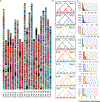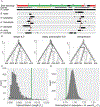Genomic architecture and introgression shape a butterfly radiation
- PMID: 31672890
- PMCID: PMC7197882
- DOI: 10.1126/science.aaw2090
Genomic architecture and introgression shape a butterfly radiation
Abstract
We used 20 de novo genome assemblies to probe the speciation history and architecture of gene flow in rapidly radiating Heliconius butterflies. Our tests to distinguish incomplete lineage sorting from introgression indicate that gene flow has obscured several ancient phylogenetic relationships in this group over large swathes of the genome. Introgressed loci are underrepresented in low-recombination and gene-rich regions, consistent with the purging of foreign alleles more tightly linked to incompatibility loci. Here, we identify a hitherto unknown inversion that traps a color pattern switch locus. We infer that this inversion was transferred between lineages by introgression and is convergent with a similar rearrangement in another part of the genus. These multiple de novo genome sequences enable improved understanding of the importance of introgression and selective processes in adaptive radiation.
Copyright © 2019 The Authors, some rights reserved; exclusive licensee American Association for the Advancement of Science. No claim to original U.S. Government Works.
Conflict of interest statement
Figures




Comment in
-
Mapping footprints of past genetic exchange.Science. 2019 Nov 1;366(6465):570-571. doi: 10.1126/science.aaz1576. Science. 2019. PMID: 31672881 No abstract available.
References
-
- Schluter D, The Ecology of Adaptive Radiation (OUP Oxford, 2000).
-
- Lamichhaney S, Berglund J, Almen MS, Maqbool K, Grabherr M, Martinez-Barrio A, Promerová M, Rubin C-J, Wang C, Zamani N, Grant BR, Grant PR, Webster MT, Andersson L, Evolution of Darwin’s finches and their beaks revealed by genome sequencing. Nature 518, 371–375 (2015). - PubMed
Publication types
MeSH terms
Associated data
Grants and funding
LinkOut - more resources
Full Text Sources
Other Literature Sources

